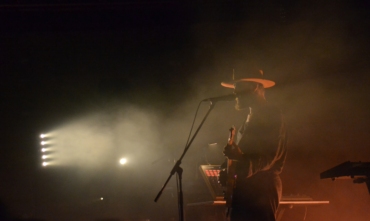Share This Article
With “Electronic Monsters,” Seasurfer return to exploring dreamlike and sharp-edged sonic territories, suspended between electronica, noise, and shoegaze.
On the occasion of their fourth album, the German band led by Dirk Knight and, for the second time, featuring singer Apolonia, tell us about the creative process, the influences that shaped the record, the value of the artistic community that surrounds them, and the free spirit with which they continue to navigate the dream punk scene.
“Electronic Monsters” is your fourth album and the second one featuring Apolonia on vocals. How has your musical chemistry evolved since your previous release, “Zombies”?
“Zombies“ was done and released in the beginning of the pandemic. Live-Shows were booked and cancelled. And we all were getting a little bit mad in these times. I did some featured releases with different singers after that. But somehow we found back together again and we now know more than before how to deal with each other. That’s great.
Dirk, you mentioned drawing from all the sounds that shaped you — from ’80s influences to shoegaze and dark electronics. Can you tell us more about how these elements merged in the creation of “Electronic Monsters”?
We started with Seasurfer with the first two albums more like a classic band and wanted to create a noisy Shoegaze sound, also as a contrast to my former ethereal dreampop band “Dark Orange”. Today it is less a conceptional idea but more a flow. I grew up in the 80s with New Wave and Dark Wave but also electronic stuff like Visage, DM. I‘m getting a little bit bored about this old fashion Shoegaze-sound, i don’t want to feel like an oldie and being forced to make music that sounds like it’s 40 years old. Better to break out and be free and let it all come, combining roots with modern influences.
The album features collaborations with several guest singers, including Gloria Endres de Oliveira, Jana Marie, and Jade. What inspired you to include these ethereal voices, and how did each contribute to the album’s sonic identity?
I know Gloria from my old label, Reptile Music, and I love her depth and intensity. She made a great album with Dean Hurley. Jade and Jana Marie are from Hamburg and are friends of ours. Twice a year, in the summer and winter, we all meet here at my place for an open-air party with drinks and dancing. It’s an artist community. I wanted the album’s sound to be broad, and different voices fit in. Each has its own style and character.

You describe some tracks as “electronic monsters.” Can you talk about a specific song on the album that you feel best represents this idea and why?
There are two songs for me: “Get burned.” The idea came to me while we were dancing to DAF’s “Der Mussolini.” But of course, I still had to play a little bass and guitar. And “I love you, you hate me.” This song has everything I love and am: ethereal vocals, a cool beat, bass, and electronics. But “Collapsing” is also part of it, with electronics and a wall of sound guitar in the background. And a clear statement: We all don’t need and don’t want old men’s wars!
Seasurfer has always blended dream pop, shoegaze, and electronic elements, but “Electronic Monsters” seems to push that even further. Was there a deliberate intention to explore new sonic territory on this record?
Phew, it’s more of an evolution. It certainly has something to do with the fact that I make all the music on my own and we’re no longer a typical band. But I also just love combining electronics with bass and guitars. Maybe my Joy Division and New Order roots are coming through here!
Dirk, having collaborated with legends like Robin Guthrie, Jason Corbett, and John Fryer, how have those past experiences influenced your approach to this album?
All of these musicians have inspired me in their own way, and I’m grateful. I still remember how excited I was the first time I spoke with Robin Guthrie on the phone. I certainly learned from John how to put the singers at the center of a song. I’ve seen Jason and his Actors live several times; it’s always a great evening, and he shows how you can be cool live, but also relaxed and funny.

Apolonia, your vocals add an otherworldly quality to the music. How do you approach interpreting Dirk’s sonic landscapes and transforming them with your voice?
Thank you! I like the word “otherworldly” because it describes our creative process perfectly. Usually, while listening to these landscapes and energies of his first demos, I pick out the ones that catch my mood at that particular moment and spontaneously start humming and singing to them, to find the most authentic melodies and vocal ‚reactions’ out of the subconscious. And most of the time, intuitive statements come out of these direct moments and I build/create the rest of the lyrics around them. Almost like connecting the dots of his instrumental canvases with my voice and words to finish a musical painting. That is what I love the most about our creative work flow, because he usually agrees to my first intuitive reactions very well. But sometimes he also takes my vocal tracks apart, like puzzle pieces and surprises me with really cool new interpretations of them.
With roots in the ‘dream punk’ ethos, how do you see Seasurfer evolving after “Electronic Monsters”? Is there a direction or theme you’re already curious to explore next?
I tend to go with the flow and let things develop; I don’t work according to a plan. It always depends on the mood and overall developments. We’re currently checking whether we’ll play live again next year. It’s possible that we’ll do extremely spherical songs or noisy cold wave stuff again. I’ll let myself be surprised!

